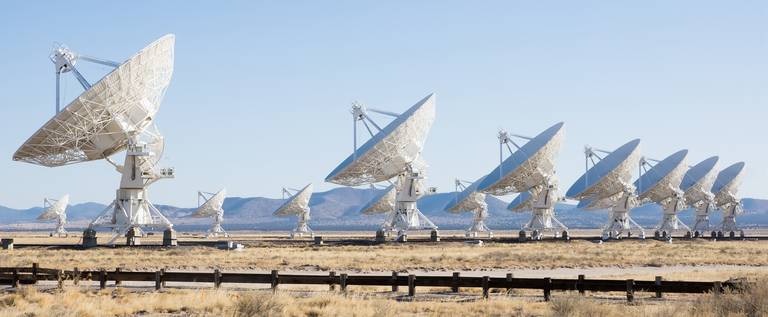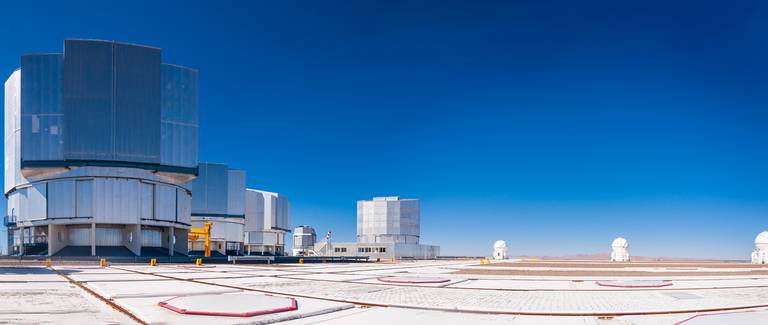History of Astronomy
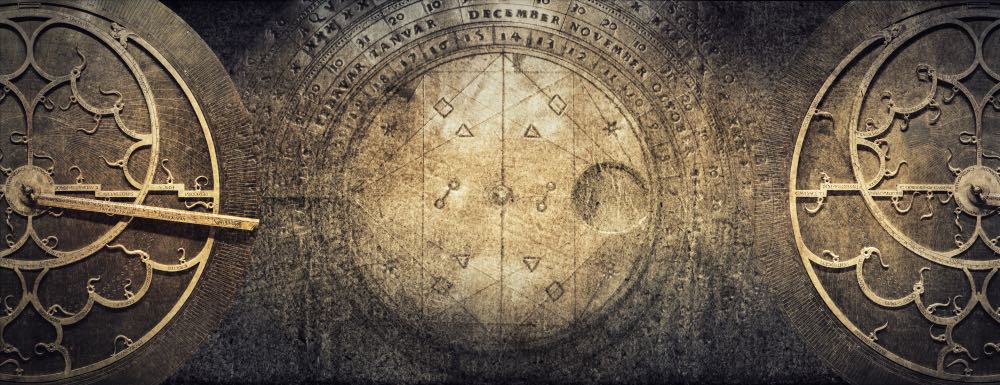
In times past, our ancestors saw in the night sky a familiar object that marked the seasons and aroused curiosity. In the heavens, they sought answers to the hardships that befell them and deduced that hidden in the stars was a truth that evaded them. At nightfall, they gathered by the fireside and observed the stars. There, they saw the celestial figures we now call constellations, and they sometimes wondered about their own place in this pantheon.
Today, of the more than seven billion people who live on Earth, just over half live in urban areas. As soon as night falls, the various artificial lights take over for the Sun and envelop us in a halo of light that effectively cuts us off from the nocturnal sky. The inhabitants of the cities and their surrounding areas no longer see the stars scintillating above them. If you live in one of these places, there is a good chance that you haven’t seen a constellation in a very long time.
Head lowered and lost in the contemplation of our various screens, we have lost contact with the sky and the curiosity of our ancestors, who attempted to unravel the mysteries of the heavenly canopy, perhaps clumsily, but by asking questions. Here, we will try to reinvigorate an interest in the stars and to see which questions we can answer and which mysteries we manage to unravel.
For a long time we have believed that Earth was the immobile center of the Universe and that the Sun, the Moon, the planets and even the stars revolved around it. Indeed, if one observes the night sky, one sees that the heavenly bodies rise in the east and then traverse the sky before setting in the west. In the absence of modern astronomical knowledge, it is natural to arrive at the conclusion that the skies and all that they contain revolve around us. It is why the geocentric model—the vision of a Universe in which Earth was at the center—more or less prevailed until the end of the sixteenth century, subsequently replaced by the heliocentric model, which places the Sun at the center. What is interesting to note is the resistance to which this paradigm shift was met, even by astronomers and scientists of the time. To understand why, let’s see how this change occurred.
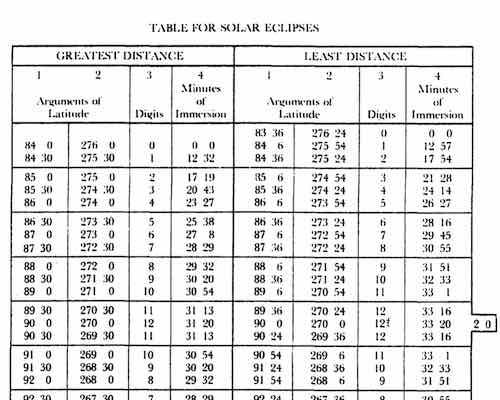
Excerpt from the English translation of
the Almagest.
G.J.Toomer
Predicting the movements of the celestial bodies as well as the eclipses of the Sun and Moon were important for sailors, astrologists, priests of the ancient religions and as a general rule for all who needed to worry about the passage of time and things from overhead. In antiquity, Ptolemy established the first astronomical tables in his work the Almagest (or Mathematical Composition). The English version can be downloaded here: Toomer's English translationToomer's English translation (PDF, 26.2 MB). He also describes the cosmology as it was perceived at the time, that is to say, as a Universe with a round Earth at its center surrounded by spheres that carried the stars. Included among these stars are the planets, the Moon and the Sun. By representing all of these stars revolving around Earth as perfect circles, Ptolemy was inspired by the models imagined before his time in which the perfection of the circles attested to the perfection of the Kingdom of the Gods.
The problem with this kind of model is that it doesn’t correspond to the observations, if they are precise. When one notes the position of the planets in relation to the stars, they seem to slow down, accelerate and even to go backwards. To account for these discrepancies, Ptolemy added a second orbit of the planets. He imagined each planet tracing a small orbit, called an epicycle, around an imaginary point, which itself traced a larger orbit around Earth, called a deferent. In the figure above, the apparent movement of the planet, as seen from Earth, is represented by a blue line. This system, ingenious but complex, was an attempt to make the theory work with the observation. To say the least, this representation, although it works, is far from being elegant or simple. It more or less takes the observation results into account, but without actually representing reality.
In spite of it all, this geocentric vision prevailed until the beginning of the sixteenth century. If heliocentrism—the idea of a Universe in which the Sun, and not the Earth, is at the center—sparked debate, nothing at the time gave reason to think that this theory was better. Then, astronomers had very few means of observation aside from their eyes; the astronomical telescope would come later, and the mathematical tools at their disposal did not allow them to decide between the two hypotheses.
The beginning of the heliocentric revolution
It is around 1530 that astronomer Nicholas Copernicus published his work On the Revolutions of the Heavenly Spheres in which he affirms that Earth is not immobile, but like the other planets revolves around the Sun. One of the motivations that inspired Copernicus when he decided to place the Earth at the center of the solar system in the absence of any new evidence was the elegance of the system in relation to the geocentric models. Ptolemy’s system worked, but it was complex and Copernicus had the feeling that an elegant and simple theory was better able to describe the true nature of things. In his solar system, the planets trace simple circles around the Sun, without having to add anything in order to correspond with the observations. If at the time Copernicus’ works were impressive because of their mathematical richness, they struggled to convince. You see, it’s that in science, a paradigm shift is not always easy to accept. It was true then, and it is true today. This is especially true when the new vision of the world that one proposes is not in keeping with our intuition or our direct observation, as in refuting the fact that the Earth is immobile and that it occupies the center of the Universe, when one can clearly see that the Sun, the Moon and the other stars rise on one side of the horizon and set on the other.
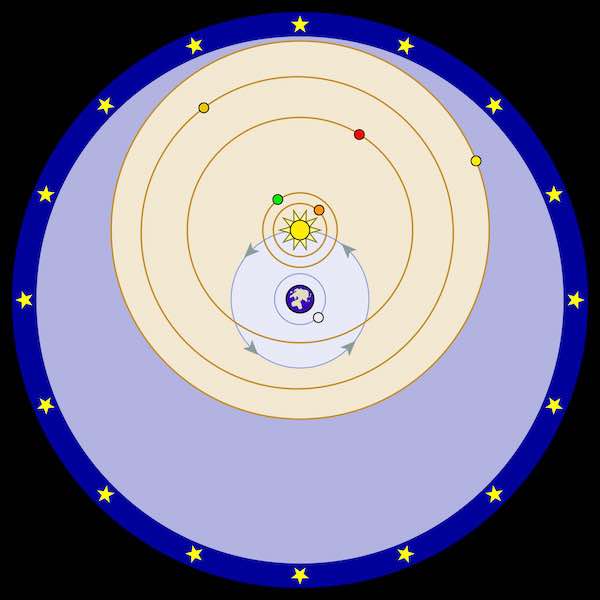
Solar system according to Tycho Brahe.
Source Wikimedia Commons
Thus, coming after Copernicus and having read his works, the astronomer and talented observer Tycho Brahe changes our understanding of the Universe by rejecting the then popular idea which held that the planets and the stars were attached to invisible celestial spheres. Nevertheless, he himself had trouble adhering to heliocentrism; he refused to adopt it and preferred a less elegant compromise: for him, the Sun revolves around the Earth, which once again becomes the immobile center of the Universe, and the other planets revolve around the Sun. His opposition to a heliocentric system stemmed from his own observations, but also from the religious beliefs that guided him.
A shift in paradigm
The paradigm shift will occur at the beginning of the sixteenth century thanks to Johannes Kepler, Tycho Brahe’s assistant. Kepler admires the quality of Brahe’s observations and will laboriously use them to establish his model of the solar system. If he understands that the Sun is in fact at the center, he is initially blocked by his own refusal to admit that the orbits of the planets are not perfectly circular. The idea that the heavens represent a place where perfection reigns is difficult to abandon and Copernicus’ circular orbits deliver this perfection in a satisfying manner. Unfortunately, Copernicus’ solar system doesn’t work very well and Kepler has difficulty making it coincide with the movements of Mars using Tycho Brahe’s painstakingly recorded observations. Kepler will thus pursue this work until 1609 when he publishes his oeuvre New Astronomy, in which he finally presents a solar system where the planets revolve around the Sun, not by traveling in perfectly circular orbits, but rather in ellipses. He will also formulate the three laws of orbits that are still used today and which bear his name.
A closer glance at the sky
In Italy that same year, the mathematician Galileo Galilei is building his famous astronomical telescope, which is in fact an improvement on the telescope invented in the Netherlands and which he manages to recreate and improve upon. Having had the idea to use it to observe the sky, he made some discoveries that seriously called into question the cosmology of the era, whereby the Earth was a place of corruption, while in the skies perfection reined. In fact, Galileo discovers that the Moon is not a perfectly smooth sphere as one had imagined. There, he sees craters and mountains, which represent a world that much resembles our own. He also notices that Jupiter possesses four moons and thus demonstrates that the celestial bodies can revolve around another body as well, and not only around the Earth, as had been believed. These observations profoundly shook the views of the era, as this time it wasn’t a question of theory, but of reproducible observations, which could be witnessed by all to whom Galileo had demonstrated his invention.
Galileo naturally concurred with Copernicus’ heliocentric vision, which earned him a trial by the Inquisition and to be placed under house arrest for the rest of his life. He died in 1642 and, by happy coincidence, Isaac Newton—another genius who will fundamentally shake up modern science—is born the following year.
Newton and the universal law of gravitation
One of Newton’s major contributions, and probably the one for which he is best known, is the universal law of gravitation, which he formulated based on Kepler’s three laws. He succeeded in linking two seemingly independent phenomena: namely that of the movement of the planets and falling objects on Earth. Newton intuited that there existed a force of attraction between objects that was proportional to their mass and to the distance that separated them. He ended up discovering that the force that caused the planets and their satellites to orbit, and which made the famous apple fall to the ground, were one and the same force that governed the movement of objects in space. His law of gravity is still used in astronomy and astronautics today.
However, Newton’s work is not limited to gravity; he made discoveries in optics and invented a new and much more efficient telescope than Galileo’s, the principle of which is still widely used by amateur and professional astronomers alike. The findings of his work are featured in his monumental oeuvre “Mathematical Principles of Natural Philosophy,” published in 1687, which describes the mathematical laws of movement and gravity. With this book, Newton also lays the foundations of the modern scientific method. Nevertheless, although Newton had understood the workings of gravity which shook the very core of the idea we had of the Universe at that time, he never understood its cause. He didn’t know what this force represented, nor from whence it came.
Einstein and the general relativity
We would have to wait until the start of the twentieth century and the work of Albert Einstein on general relativity, published in 1915, for our understanding of gravity and the Universe to evolve. Einstein discovered that space wasn’t an abstract void in which matter was dispersed following the Big Bang, rather on the contrary: that it was an object in and of itself with its own properties, on which matter could act and be acted upon. Indeed, all mass bends the part of space in which it is located and is subjected to the curvature of space. Since the space that surrounds us and in which we evolve is a three-dimensional object, to represent its bending is impossible, thus we need to have an analogy like the one in the figure below, which you may have already seen.
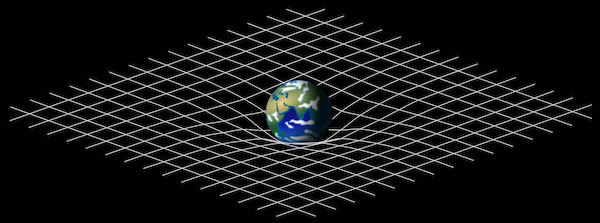
Mysid
It is customary to represent the curvature of space caused by a massive object by removing one of the dimensions and reducing space to a simple, supple, two-dimensional surface on which we can place, for instance, a globe. By doing this, we notice that the two-dimensional surface bends into a third dimension. This is how a massive object deforms the three-dimensional structure of space. It is easy to imagine that an object passing close to our earthly globe, positioned on its supple surface, would inevitably be drawn to it. The gravity represents the effect of the deformity of the structure of space on these same objects.
Using a flat surface and a globe to discuss gravity provides a good analogy. It gives us an idea of what Einstein’s equations of general relativity tell us, but like all analogies that simplify complex equations, this one is marred by a certain number of flaws. For the moment, only one interests us. While Isaac Newton’s considered time absolute, that is to say that time elapsed in the same manner everywhere, Einstein proved that time and space are dimensions of a more general object: space-time. The presence of a mass distorts space as we saw above, but it also distorts time, since time is none other than one of the four dimensions of space-time. The dimension of time is indistinguishable from the three dimensions of space that are familiar to us. The result is that if one compares two identical clocks, one situated near a massive object, on the surface of Earth for example, and the other in space, one observes that after a moment the two clocks vary. Given that they both work perfectly and that they keep time at the same pace, the one situated on Earth will end up lagging behind the one that is in space and far from all mass.
Time moves at the same pace in each case, yet the presence of a mass—in this case Earth—stretches distance as well as time. The result is that any comparison between the two clocks will reveal a difference. By demonstrating this effect, Einstein proved that time wasn’t universal as Newton had imagined, but that each point in time-space had its own frame of reference. Although time passes in the same manner locally, it does not necessarily pass in the same manner between two distant points. Nevertheless, it is easy to reach the same conclusion as Newton, because like the apparent rotation of the sky and the stars, which seem to indicate that everything revolves around us, nothing at our level allows us to imagine that time and space are elastic and that all measure of distance and time are valid only locally. Einstein made us change the paradigm; by considering things from a different point of view, he made us better understand the result of our past observations. With general relativity, the true nature of the Universe appears strange to us, because the laws of physics that apply to the infinitely large and to objects that move close to the speed of light are completely counterintuitive at our scale.
The weirdness of the quantum world
During the same period, the early twentieth century, another revolution was born that would once again find fault with our intuition and would offer new perspectives on reality. This revolution is based on copious observations made in the past and on the work of numerous people, including Einstein. It does not concern the infinitely large, but rather the infinitely small. Quantum Mechanics shows us that the elementary particles that compose all matter of the Universe act in an extremely strange manner—a discovery which still gives rise to philosophical debates today.
The existence of the atom as the basic building block of matter was first proposed in the modern era at the beginning of the seventeenth century by the physicist John Dalton. In 1897, another English physicist, J.J. Thompson, discovered the electron, a negatively charged subatomic particle located near the center of an atom. In 1911, the New Zealand physicist Ernest Rutherford discovered the atomic nucleus at the center of the atom. Little by little, an image of the atom began to emerge, with the negatively charged electrons revolving around a nucleus composed of positively charged protons and of neutrons without any electrical charge.
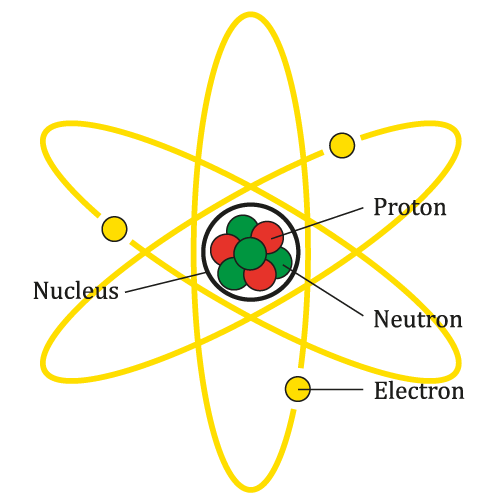
AG Caesar
This description of the atom is reassuring, because it resembles, in miniature, a solar system with planets that orbit around the Sun. The infinitely large and the infinitely small thus obey the same laws, and physics is a gentle continuity. So, we can conclude this article and move on to something else.
Not really. A number of physicists including Louis de Broglie, Werner Karl Heisenberg and Erwin Schrödinger will highlight something very disturbing that will disrupt this vision of the atom, as well as our view of reality. The first difference and initial anomaly that Quantum Mechanics reveals is that the electrons only seem to be able to occupy a certain number of “orbits” around the nucleus. They can never be between two “orbits,” and this word is purposefully in quotation marks, because it isn’t a question of orbits, but of energy levels. We won’t get into the details of Quantum Mechanics, as it is a subject that warrants numerous articles, but we will do a brief summary of what is currently known about the behavior of matter on the subatomic scale. First of all, the elementary particles possess a dual nature, they behave as much like point-like objects as waves, depending on the situation. The reality is that these particles aren’t really one or the other. They are objects that have a certain number of properties: one position, one speed, one electrical charge, and so on. Among these properties, some can never be known at the same time and with the same precision. For example, the better we know a particle’s position, the less we know about its speed, and vice versa. This isn’t the case with a billiard ball whose position and speed can both be known with extreme precision, but as soon as we get into the infinitely small, we quickly run into behavior of matter that is very different from what we are used to on our scale. Even worse, a particle does not have a position before having been observed! Prior to observation, a particle is in a state of quantum superposition, there are a certain number of probabilities to find it in this or that place, if a measurement is made, but it is impossible to say that it is either here or there. And it gets even worse. Let’s take a photon, the particle that serves as a vector for light, and let’s divide it into two photons. These two particles will find themselves in what we call a state of quantum entanglement and will in some way constitute a single system. Measuring a property on one of these photons will have an influence on any measure of the same property made on the other photon. If for example the spin of a photon has a certain value (the spin is a quantum property that has no comparison to larger scales), a measure of the spin of another photon will systematically reveal a different value. This effect is immediate and independent of the distance that separates the two particles even if they were to be situated at opposite extremities of the observable Universe!
What do we know?
This is approximately where we are today in our comprehension of the Universe. On one hand we have Einstein’s theory of general relativity, which accurately describes the space-time and behavior of matter subjected to gravity. On the other hand, we have quantum physics, which describes with extraordinary accuracy how this same matter behaves in the world of the infinitely small. The problem with which we are confronted—and on which Einstein himself stumbled—is that these two sets of laws, which continue to be demonstrated by experimentation and observation, and which allow us to make factually accurate predictions, are completely incompatible with one another. And it’s a problem that has very real implications, because there are two instances in which the matter finds itself compressed within an infinitely small point, literally infinitely small, and where the general relativity and quantum physics simply cease to make any sense. It is about what are called singularities, which are found at the center of black holes as well as at the very beginning of the Big Bang.
These singularities and the collapse of the two pillars of physics, the general relativity and the quantum mechanics, which explain everything that happens in the Universe, signify that we are confronted, once again, with having to change our point of view, consider things from a different angle, and be open to a new paradigm that will allow us to reunite general relativity and quantum physics into a “theory of everything” – an actual holy Grail of physics that will allow us to better understand reality and the place that we occupy within it.







